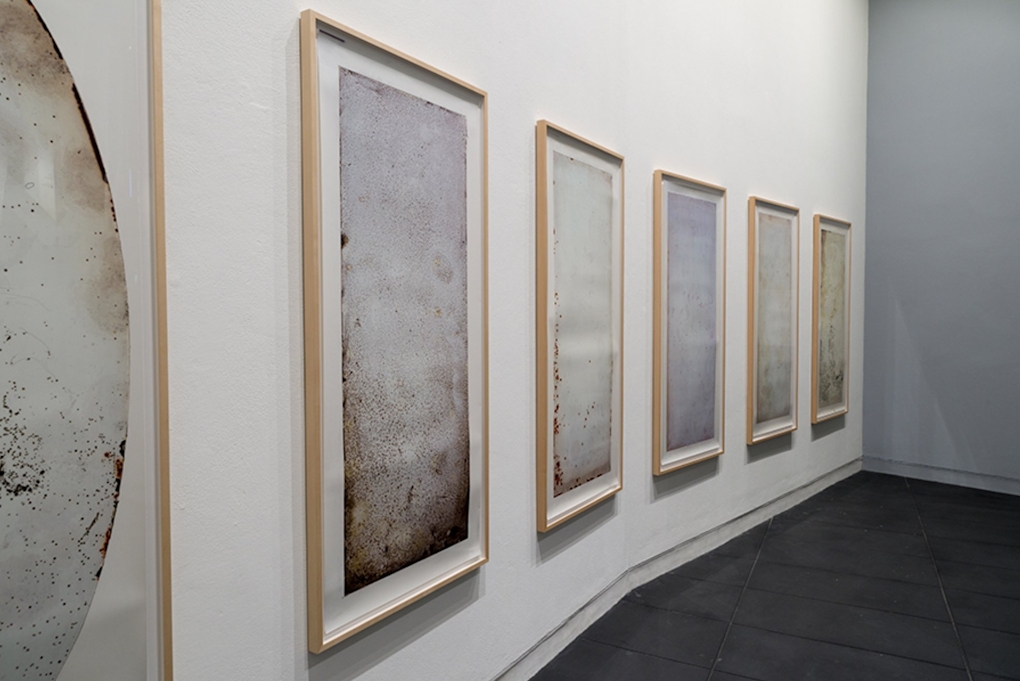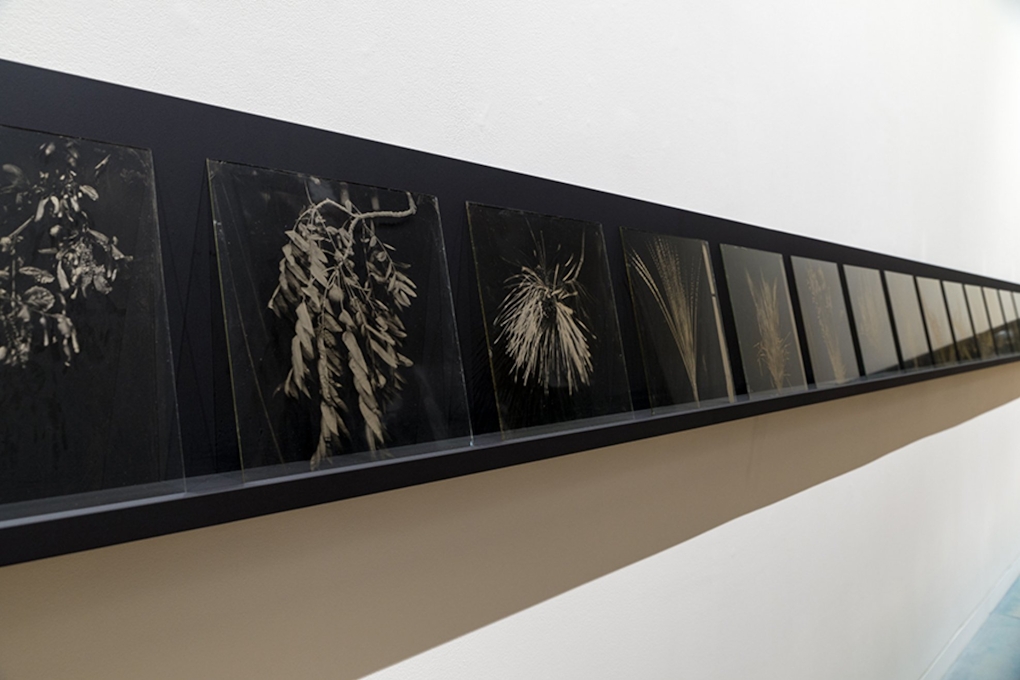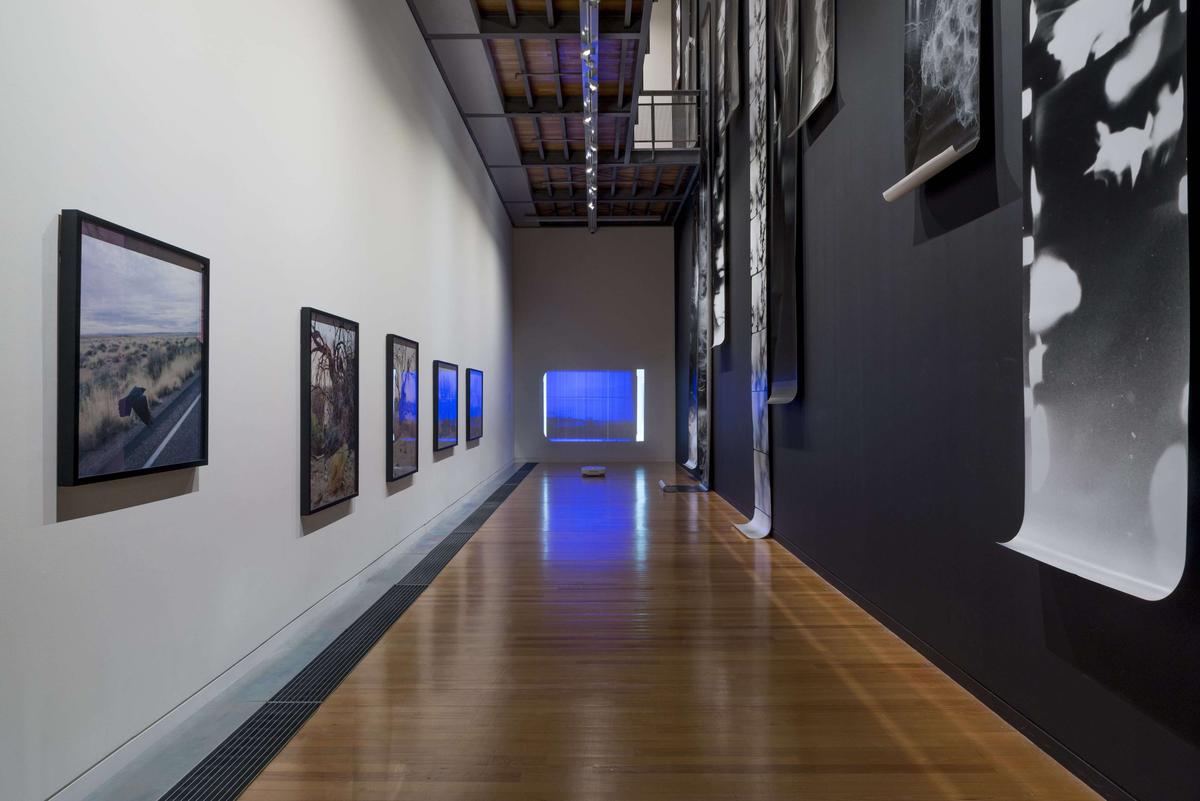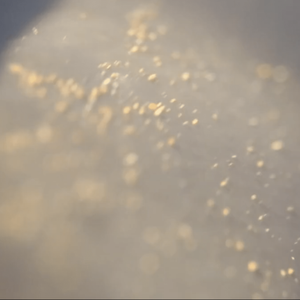On one version of the story, photography could finally be born only with the convergence of two very different disciplines—optics and chemistry. If the optics was fairly well established in camerae obscurae and diagrams of the eye, the chemistry was (as might be expected) messier, and more experimental, with stages, refinements and competing formulae that I won’t (and can’t) narrate here. The progressive encapsulation of the two disciplines within a single apparatus and industrial process—as if photographic image making were ever a simple, coherent thing, a push of a button—obscures the echo of their meeting, and the ways in which much of photography’s history might be staged as a long conversation between them.
For those of us who have seen Joyce Campbell’s overlapping shows On the Last Afternoon: Disrupted Ecologies and the Work of Joyce Campbell and Te Taniwha: The Manuscript of Ārikirangi at the Adam Art Gallery, the evocation of photography’s early history might be obvious to the point of redundancy. She is one of those photographers who, using a range of early, messy techniques—ambrotypes, daguerreotypes, wet-plate collodions and gelatine silver photographs—dials back the years to the point before the lens and the light-sensitive surface were so neatly joined. We could, then, think of her alongside Ben Cauchi and other contemporary artists experimenting with early photography. Or we could follow broader historical associations: the century of photography’s birth necessarily evoking that century’s colonialism, land alienation and clearances. Indeed, Campbell’s choice of subject matter encourages such associations, as in her moving 16mm film triptych Ghost Scrub (2018), which juxtaposes a contemporary clearance (by aerial spraying) with the sounds of an untouched native landscape (recorded in Campbell’s parents’ private bird reserve).
I will, to be sure, touch on these themes below, and on the associated tension between the camera’s alliance with colonial power and the whiff of technical nostalgia. However, I think a closer engagement with image-making itself comes from the technical dialogue with which I began, between the lens and the application of sensitivity to light.
The action of the racehorse’s legs and the smoke around a speeding bullet reveal themselves, as much as do the elusive past moment and the finest wrinkle of a frown.
How do optics and chemistry become wound up in ideas and practices of photography? To begin with, it has often been too easy to associate the camera mostly with its lens. That forward facing and visible aspect seems to resemble an eye, suggesting a point of view or a gaze; and furthermore a male, colonial and disciplining gaze; a surveilling (or at best sousveilling) one. Optics, we might say, emphasises the distance between viewer and object, and the stasis of the apparatus, making light over into the abstract play of converging lines, and image making into the passive act of a separate, one might say Cartesian, knower.
Chemistry, however, stands for something else. It suggests bodies and embodied processes, the labour of the darkroom, the dipping of plates and the application of fluids and vapours. It invokes not distance but contact and mixing. The work of chemistry is also the work of fixing a moment, and it therefore concerns time itself, and the cutting of it into a series of nows—and so also the mark, trace or detection of the most fleeting of essences, the ‘optical unconscious’, all the things can cannot be captured by the naked eye. This is a very different aspect of the photographic process from that of the gaze, the imposing and disciplining technology so beloved of police typologists and colonial administrators. It is, so to speak, contact itself, and sensitivity—the sensitivity of the emulsion surface promising a sensitivity to the world’s various creatures and inhabitants. The action of the racehorse’s legs and the smoke around a speeding bullet reveal themselves, as much as do the elusive past moment and the finest wrinkle of a frown.
This lengthy preamble out of the way, we could do worse than to start thinking about Campbell’s show through its earliest works, the series of photograms Hosting (1998-99). All chemistry and no lens, they hint at an allegiance to the emulsion and its sensitivities rather than to the gaze. This is, of course, partly the stance of all lensless photographs, in virtue of working directly with the emulsion surface, and with a surprising and experimental procedure in which the outcome is never seen and tested by the eye before development. It also has to do with the tactile quality of these particular pieces. They do not, as with many photograms, record the shadow of an object—still an optical phenomenon, after all—but mark the activity of bacteria directly on the surface. Akin to petri-dishes or agar plates, they are the result of an interaction of a chemical surface with life itself. They find visual echoes throughout the exhibition’s dialectic of material and image: their mottles and stains repeated, say, in the blemished surfaces of the series of Last Light (2006), daguerreotypes made in Antarctica in 2006; and their occasional pictorial hints of a fugitive nature, in the tree-like structures of bacterial growth.

Installation view of On the Last Afternoon: Disrupted Ecologies and the Work of Joyce Campbell and Te Taniwha: The Manuscript of Ārikirangi (2019) Joyce Campbell, Adam Art Gallery
The emphases on touch, surprise, life’s and the world’s interaction with the camera recur throughout these shows: the moving image work The Reef (2018) is scarred with the scratches of sand on the film surface, made during transfer from 16mm to video; Company Stream (2017) is described by the wall text (a little less convincingly) as a "haptic visualisation." Such sensitivities might show us something of the camera’s potential to escape its colonial vocation for police mug shots and ethnographic typology—but there are points in the exhibition where the suggestion of sensitivity is overdrawn and unconvincing. I am thinking especially of Ice Ghoul #2 (2006) from Last Light, where a face or skull seems to loom forward from the shape of glacial ice, emerging under the darkroom’s safelight, we might imagine, to the shock of the lone photographer sequestered there. I am unconvinced by this apparition and its suggestion of spirit photography, as if old techniques by virtue of their very imperfections reveal something: lens flare or darkroom thumbprint as ghost! This seems too much like nostalgia, old techniques producing moody, dark and suggestive images. Indeed, seeing ghosts in this way seems to me to have little to do with sensitivity—I suspect it is much more to do with the gaze, with our contemporary horror-movie obsessions and optical impositions. Campbell believes, according to Disrupted Ecologies’ wall text, that ‘modern cameras and their standardised prints do not lend themselves to the depiction of subtle or “mysterious” things and events’—but this cannot, I think, best be understood in terms of ghost stories.
Joyce Campbell, Company Stream (2017) excerpt. Commissioned by CIRCUIT
How, then, do we think of the title and provocation of Te Taniwha, Campbell’s extended collaboration with Richard Niania? There is indeed a suggestion that, through Campbell’s images from around Whakapūnake and the Ruakituri awa, the taniwha Hinekōrako, however subtly, reveals herself. I fully accept this, but—and I should emphasise that this is a guess and a suggestion, and that I have no authority in the matter—it means that taniwha are not at all the same kind of thing as ghosts or ghouls. Hinekōrako’s current form is a giant eel, and there are eels visible in the show in Company Stream and Taniwha I-IV and VII (2010); but to me she is most convincingly present where she is felt rather than seen. I can’t really say how taniwha reveal themselves, but I suspect it has less to do in general with vision than with contact—with physical, biological, even chemical touch, the shifting and force of the riverbed, the water and the tuna.
.jpg)
Installation view of On the Last Afternoon: Disrupted Ecologies and the Work of Joyce Campbell and Te Taniwha: The Manuscript of Ārikirangi (2019) Joyce Campbell, Adam Art Gallery
As I have suggested, then, it is where it emphasises materiality rather than mystery that Campbell’s photography is most successful. It is there in the large wall hangings in As it Falls (2004 and 2019)—material in their sheer size and the ways in which the prints warp and spill down the height of the wall between the upper and lower galleries. Or again, it is there in how the daguerreotypes and ambrotypes emphasise their material substrate: the metal of the Last Light or glass of LA Botanical (2006-7), with the image a palpable layer and texture on each. Indeed the very fragility of the long row of glass plates in LA Botanical contributes, somewhat accidentally, to the sense of material sensitivity. LA Botanical is an attempt to document all of the surviving plants native to Los Angeles with recorded uses—and what clearer case of embodied connection to our subject could we want than the harvesting, drying, pounding, powdering, applying, ingesting and smoking of these plants? LA Botanical offers documentation of them, though it is less concerned with information than with trace, with a record of contact, even (as with the Antarctic images) with a formal tenuousness that embodies something of the precarious status of its subject.

Installation view of On the Last Afternoon: Disrupted Ecologies and the Work of Joyce Campbell and Te Taniwha: The Manuscript of Ārikirangi (2019) Joyce Campbell, Adam Art Gallery
How we judge Campbell’s photography might come down to how we judge the ability of the camera to put an idea of contact and connection into practice, and, perhaps, her insistence that old cameras do it better than new ones. I remain just a little unmoved by the latter suggestion, and the hope placed in ‘mystery’ (itself a cinematic and genre term) as if in a desperate rearguard attempt to reinsert a faded aura into photographic practice. If I am right, it is the wager of Campbell’s best photography, and our best reading of it, to emphasise the camera’s sensitive aspect. This is the wager according to which sensitivity becomes akin to whakapapa, the concrete and physical linking of bodies (and so images) to the bodies from which they originate, and which becomes an ecological principle in its own right—the interconnection of all things—even while it insists on particular links, debts and genealogies rather than any vague holistic background.
Here, I think, is once again the thing itself, living and thriving through contact with its image.
I have taken some time to get to what is undoubtedly the exhibitions’ most significant "event": an extension of the collaboration with Niania, it is a documentation, and the very first public outing, of a notebook gifted to Niania’s Kūnaiti Whānau by Te Kooti, among other taonga central to the founding of the Ringatū faith. Indeed, the surrounding exhibition, and hopefully my own writing about it, might be seen as a protective cloak for these taonga and preparation for thinking about them. It is here that ideas about photographic sensitivity come into their own, alongside the constellation of related terms: contact, whakapapa, and the hope that, rather than reducing and disciplining what it records, the camera might allow it to thrive in image form. There was no doubt at the opening about the importance of the book and the images for members of the whānau present. I can only guess at the personal, cultural and religious significance of the pages of actual whakapapa that reach back to the creation. Significantly, though, it was clear to me through brief conversations with one or two members that the photographs were as moving as the presence of the notebook itself. I am assuming that something of the status of images in Māori practice is in play here: the way the presence of the image becomes a strong link to, and the very presence of, who or what it depicts, just as poupou or photographs in the wharenui are talked to and introduced as people. I am not the person to develop this theme, but I suspect it has to do with whakapapa, with the birth of the image out of the subject, with contact and presence and, I daresay, with something like chemistry. Here, I think, is once again the thing itself, living and thriving through contact with its image.
Of course, I don’t want to reduce a powerful and significant engagement to a question of photographic technology. I hope it is clear, instead, how the camera and its workings might be enrolled in a larger set of questions: how things and people are connected, and how to develop the sensitivities to further and expand those connections. Campbell’s practice at its best, with all its collaborations and engagements, offers a demonstration of how to work with and extend those possibilities.
Many thanks to Pauline Harris for the kōrero about this review - TC

